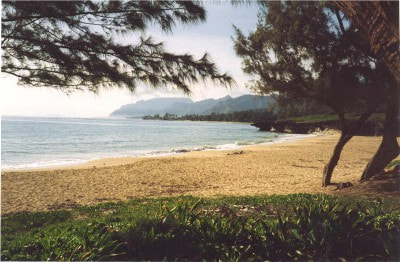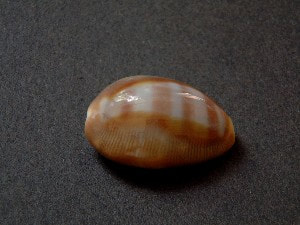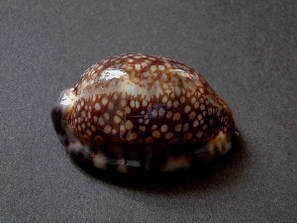Shelling in Hawaii, Tahiti and the Cook Islands
by John and Goga Batt
Photography by John Batt
Photography by John Batt

On the 23 May 1998, my wife and I set off on our first shell collecting trip to the tropics together to Oahu Island, Hawaii. After what seemed like a never-ending flight we arrived at our Hotel in Waikiki at 11:30pm and checked into our room.
The following morning we woke up early and decided to check out Waikiki and Honolulu. We were suprised to find very few shell shops around, and those we did find seemed to be selling Philippines or Florida shells and none endemic to Hawaii or the South Pacific Islands. We did find a pet shop near Honolulu Harbour which had a room set aside with worldwide specimen shells for sale. We introduced ourselves to the owner, a keen conchologist belonging to the Hawaiian Shell Club. He invited us to see his shells, and after chatting for some time we purchased a nice 40mm Luria tesselata, Staphylaea semiplota, Lyncina sulcidentata all from Oahu Island, as well as Strombus vommer vommer and a melanistic Erronea caurica from New Caledonia and a Zoila decipiens from NW Australia, all at very reasonable prices. As a collector I am interested in six families including Harpidae, Strombidae, Cassidae, Ranellidae and Muricidae, but my real passion is with Cypraeidae, so I asked him if he had any spare Erosaria ostergaardi. He said he did not have ostergaardi in his own collection, and that only a couple of live specimens are taken in a year, and that most specimens dredged are broken – my hopes of obtaining one were somewhat reduced. By this time a frustrated wife, longing for some solar rays, removed me from the shop and led me to the nearest beach.
The following morning we woke up early and decided to check out Waikiki and Honolulu. We were suprised to find very few shell shops around, and those we did find seemed to be selling Philippines or Florida shells and none endemic to Hawaii or the South Pacific Islands. We did find a pet shop near Honolulu Harbour which had a room set aside with worldwide specimen shells for sale. We introduced ourselves to the owner, a keen conchologist belonging to the Hawaiian Shell Club. He invited us to see his shells, and after chatting for some time we purchased a nice 40mm Luria tesselata, Staphylaea semiplota, Lyncina sulcidentata all from Oahu Island, as well as Strombus vommer vommer and a melanistic Erronea caurica from New Caledonia and a Zoila decipiens from NW Australia, all at very reasonable prices. As a collector I am interested in six families including Harpidae, Strombidae, Cassidae, Ranellidae and Muricidae, but my real passion is with Cypraeidae, so I asked him if he had any spare Erosaria ostergaardi. He said he did not have ostergaardi in his own collection, and that only a couple of live specimens are taken in a year, and that most specimens dredged are broken – my hopes of obtaining one were somewhat reduced. By this time a frustrated wife, longing for some solar rays, removed me from the shop and led me to the nearest beach.
The following day we took the Wiki-Wiki bus to Hanauma Bay, a marine reserve with a wonderful beach and coral reef. The snorkelling here is excellent with many beautiful species of fish such as Moorish Idols, triggerfish, parrot fish, angels and moray eels plus the chance to swim with turtles, but suprisingly not much in the way of shells. As we were in Hawaii for just four days it was difficult to find good collecting areas, but on our final day luckily we met a diver on the beach at Kailua Bay, who we talked to for some time about shells. He invited us back to his home where he showed us a video which he filmed himself underwater. It included a clip of him taking a large Cypraea tigris schilderiana from a rock crevice in about 8m of water – he handed me the specimen and said "take it back with you and put it in your collection". I was thrilled and thanked him as I didn't have one. Later that day we spent some time on the beach near Honolulu Harbour and were able to catch low tide. At the harbour mouth there is a rocky area where we found many common species including Erosaria caputserpentis caputophidii (everywhere), Erosaria moneta, Blasicrura teres pellucens and Erosaria helvola hawaiiensis.
That evening at midnight was our onward flight to the island of Rarotonga in the Cook Islands. There are fifteen islands in the Cook group of which Rarotonga is the most populated, with around 11,000 residents, about half of the total population. This beautiful island with its high volcanic peaks is ringed by a wonderful coral reef which provides a safe lagoon for snorkelling and swimming. We arrived at 6am at our hotel, the Edgewater Resort and after depositing our bags in our room, headed straight for the beach to see what we could find washed up. The beach was littered with pieces of broken coral, obviously washed up on the beach during hurricane season, and amongst the debris we found Strombus mutabilis, Erosaria caputserpentis, Conus ebraeus and Conus coronatus amongst others, all in rough condition but it gave us an idea what was common on the reef. After lunch we grabbed our towels and returned to the beach for the rest of the day. At low tide the fringing reef is exposed and you can walk to it in water that is about four feet deep. We spent the next two days collecting shells in the area and found many good specimens including a very dark Mauritia maculifera, Erosaria helvola callista, E. caputserpentis, E. obvelata, Cymatium nicobaricum, C. aquatile, Nassa serta, Thais tuberosa and some huge Trochus niloticus. The following day we decided to hire a car and explore the rest of the island. We headed clockwise towards the airport and on to the island's biggest town, Avarua, where we changed some more travellers' cheques at a much better rate than the hotel, bought some presents, souvenirs and beer to stock up the hotel room fridge. We then continued our trip to Muri Beach and the island's only shell shop.
After a couple of hours at Muri Beach we continued our drive, stopping at a few dive shops on the way. The first one had a cabinet showing shells collected by the divers around the island, so I decided to introduce myself to the owner of the shop. She was glad to show me the shells in the cabinet and tell me where they were collected and the depths at which they were found. I explained to her that I was interested in cowries and had my eye on a very beautiful dark specimen of Lyncina schilderorum, so I asked if she would sell me the specimen. She said that she didn't want anything for it and also gave me a normal colour form, together with Lyncina leviathan boueti and a Pustularia bistrinotata sublaevis. The people of the Cook Islands are very generous and friendly making it well worth visiting, even if there are not as many mollusc species as the Philippines or South Africa.
At the next dive shop I obtained another Mauritia maculifera larger and much lighter coloured than the specimen I had found earlier in the week, making a nice pair of variants for my collection. Also he gave us a Blasicrura goodallii in gem condition, a Drupa rubusidaeus and another Cymatium aquatile. Very pleased with my acquisitions we returned to our hotel complex to return the car. We had a wonderful time in the Cook Islands and will surely return there, hopefully in the not too distant future.
Our last destination was the Polynesian island of Tahiti. We were very excited at the possibility of obtaining some rather rare species from this French island paradise. We were staying at Le Royal Tahitian resort, about three miles from Papeete, the main city. The beaches of Tahiti are mostly black lava sand with a few man-made white sand beaches, so the first impression of this island is not always a good one, but the natives are quick to point out that their black sand is three times finer than the white coral sand of other islands.
This may be the reason why many fresh beach shells can be found in very reasonable condition on Tahiti. The market place in Papeete is the first place for the budding conchologist to head for. Above the fish-market, up the escalator, are many stalls selling souvenirs and shells. It is surely a shell collector's heaven with many species from Tahiti, the Marquesa Islands and New Caledonia, as well as common Philippines shells. We spent a long while here looking through the baskets and tables displaying shells. In the small baskets we found dead taken Blasicrura subteres, Blasicrura goodallii, Purpuradusta serrulifera, Erosaria dillwyni and Naria irrorata, some as good as live-taken, and a 24mm Harpa gracilis which had a small dorsum hole.
Another stall was selling rostrate and melanistic cowries from New Caledonia and I could not resist three of these beauties. A melanistic and rostrate Bistolida stolida crossei, Mauritia eglantina and Mauritia scurra indica, both melanistic and going for a song. Other shells we obtained were Ipsa childreni, Cypraea tigris and Lyncina ventriculus from Tahiti and a pair of Lambis crocata pilsbryi from the Marquesas. Not a bad day's shell shopping and all under one roof. As most of you will now know, the tiny Erosaria bernardi "kingae" has been discovered living in Hitiaa, Tahiti alongside the normal Erosaria bernardi and is now understood to be just a form of that species, although the majority of specimens have come from Pitcairn Island – neither one of these two very rare species was available anywhere we looked. Another shell shop we visited had nice specimens of Cribrarula cumingii (no cleopatra anywhere), and Erosaria dillwyni, so we bought one of each and a Lambis robusta (the only one we saw all week).
We were told that dredging and trawling have been banned in Tahiti so perhaps bernardi 'kingae' will remain almost impossible to obtain as it is thought that they are from deeper water than bernardi. Nevertheless we decided to take a trip to Hitiaa for a day and do some snorkelling. The beach was littered with rubbish, bottles and tin cans – not the ideal spot for a sun-loving wife to relax but she agreed to stay a while. We found here many Erosaria obvelata, dwarf Erosaria moneta, Lyncina lynx and a Conus striatus in just a few inches of water. Later on I decided to go snorkelling and overturning some dead coral found a Cymatium rubeculum, dead but still rather nice as well as Erosaria caputserpentis and another lighter-coloured dwarf moneta, all in about three feet of water.
I then noticed a small cowrie lying on its back (aperture up), also in about three feet of water. Thinking it was just another obvelata, I picked it up and was surprised to see a species I had not yet seen. I thought at the time it was a dead Erosaria cernica but remembered that cernica always has marginal spots and this specimen had none, but had a yellow dorsum with small white spots and white callous patches on each margin rising slightly upwards towards the dorsum. It was not until we were back at the hotel looking at the fused anterior columellar teeth that we realised we had amazingly found a dead specimen of bernardi 'kingae' – possibly beached and washed back, it still retained its gloss and its faded yellow is understood to be normal for a dead specimen.
On our last two days in Tahiti we visited the seashell museum in Papara – it is well worth the time. The museum has a few shells for sale on the way out – we purchased a pair of Chicoreus maurus but with no locality data. I do not know if these are from Tahiti as it is endemic to the Marquesas.
On our last day we took a ferry ride to Tahiti's sister island, Moorea. We did not get enough time to do any collecting on this island but we hired a moped and took in the incredible scenery on this tranquil paradise, and visited a few of its gorgeous white sandy beaches.
All in all our trip to all three locations has been a wonderful experience and one that we shall never forget.
This article by John and Goga Batt was first published in our magazine Pallidula in April 1999.


